
FULGOR MILANO F7SP24S1 Electronic Ovens

IMPORTANT: Save these instructions for the local electrical inspector’s use.
INSTALLER: Please leave this manual with the owner for future reference.
OWNER: Please keep this manual for future reference.
WARNING: A fire or explosion may result in causing property damage if the information in this manual is not followed exactly, personal injury or death.
Introduction
Please read these instructions COMPLETELY AND CAREFULLY. They will save you time and effort and help to ensure optimum oven performance. Be sure to observe all WARNINGS. These installation instructions are intended for use by a qualified installer. In addition to these instructions, the oven shall be installed:
- In the United States, in accordance with the National Electric Code/State and Municipal codes and/or local codes.
- In Canada, in accordance with Canadian Electric Code C22.1-latest edition/Provincial and Municipal codes and/ or local codes.
- These shall be carefully followed at all times.
NOTE: If installing your oven in Canada please check to make sure that you have a model with us and a Canadian listing.
Mark, as shown above: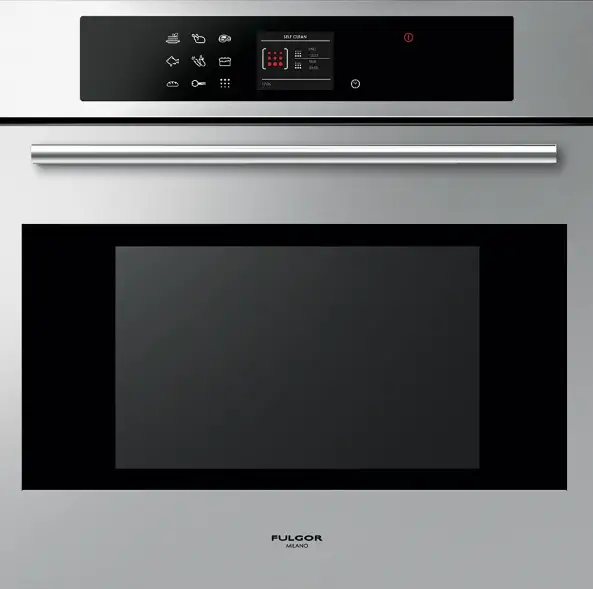
Mark as shown above means the oven complies with both US and CANADIAN Standards.
Tools you will need
The following tools are needed to install your new oven:
- Tape measure and straightedge or ruler
- Pencil
- Phillips screwdriver
- Level
- Wire cutters and wire strippers
- Hand or saber saw
- 1” (2,5cm) Hole saw
- Drill and drill bit
- Safety gloves and goggles
- Volt meter (0-250VAC)
Packaging
Remove all tape and packaging before using the oven. Destroy the packaging after unpacking the oven following the rules in force in your town. Never allow children to play with packaging material.
Power requirements
The oven must be supplied with the proper voltage and frequency. The oven is manufactured to be connected to a three-wire or four-wire, single phase, 120/240 Volt, 60 Hz AC electrical supply on a separate circuit fused on both sides of the line. A circuit breaker or time delay fuse sized not to exceed the circuit rating of the appliance specified on the rating plate located on the frame behind the door of the oven is recommended (see figure at page 6).
The oven must be supplied with copper or aluminum wires. If aluminum wire is provided to connect the oven to the branch circuit, UL-listed connectors for joining copper and aluminum must be used. Follow instructions provided with connectors. It is recommended that you have the electrical wiring and hookup, of your oven performed by a qualified electrician. After installation is complete have the electrician show you where the main disconnect is and which of the circuit breakers/fuses are for the oven.
WARNING: RISK OF ELECTRIC SHOCK ELECTRICAL GROUNDING CONNECTION
You must disconnect the neutral from the grounding lead. Connect the appliance in accordance with local electrical codes. For models rated up to 4.3kW connect to a 20A fuse or circuit breaker. For both US and CANADIAN installation: this appliance is equipped with copper lead wires and must be connected to copper wires only. Aluminum wires must not be used.
Choosing oven location
Carefully select the location where the oven will be placed. The oven should be located for convenient use in the kitchen, but away from strong drafts. Strong drafts may be caused by open doors or windows, or by heating and/or air conditioning vents or fans. Make sure that electrical power can be provided to the location selected.
Steps for installation
The following pages provide the necessary information for the proper installation of the oven and are arranged as follows:
- Technical Data
- Installation Cutout Dimensions, Required Clearances and
- Mounting instructions for:
- Under Counter Installation, Single Oven
- Wall Installation, Single Oven
- Wall Installation, Double Oven
- Electrical Connections for 3-wire or 4-wire Branch Circuit.
- Final Checklist
| TECHNICAL DATA
For cutout, dimensions see the following section titled: Preparing the location |
Electrical Ratings and Maximum Connected Load | |||
| @ 120/240 Volts 60 Hz | @ 120/208 Volts 60 Hz | |||
| Amperes | kW | Amperes | kW | |
| SINGLE OVEN | 14.3 | 3.45 | 12.4 | 2.59 |
Installation notes
- Do not slide oven across the floor. Damage to floor covering or floor could result.
- The oven support surface must be a minimum 3/4” (2cm)] thick plywood platform. For single ovens, it must support 202 pounds. The platform must be solid, level and flush with the bottom of the cabinet cut out.
- Use extreme caution when moving or installing the oven. It is very heavy. DO NOT LIFT THE OVEN BY THE DOOR HANDLE, remove the door for easier handling and installing. See REMOVING THE DOOR in the maintenance section of the Operating Instructions.
- Be very careful when moving or installing the oven to avoid damage to the oven frame or damage to the cabinets.
- Be sure to level the oven. An oven that is not level may provide poor or inconsistent baking results.
- Be careful when placing the oven. DO NOT pinch the conduit between the oven back.
WARNING: Before installing or removing, turn the power OFF at the service panel. Lock service panel to prevent power from being turned ON accidentally. Securely fasten oven to cabinet using the screws provided. Failure to do so could result in the oven moving or tipping during use and causing damage to the oven or cabinets or personal injury. Know how to disconnect the power to the oven at the circuit breaker or fuse box in case of an emergency.
CAUTION: The unit is heavy and requires at least two people or proper equipment to move.
| Later. | DIMENSION | SINGLE | ||
| 24” | ||||
| A | Cutout Width | 22 | 1/16” | (56 cm) |
| B | Cutout Depth | 22 | 1/16” | (56 cm) |
| C | Cutout Height | 23” | (58.5 cm) | |
| D | Oven Position (distance from floor) | 34” | (86.5 cm) | |
| E | Minimum Spacing | 1/2” | ( 1.3 cm) | |
WALL OR UNDER-COUNTER INSTALLATION, SINGLE OVEN

CAUTION
- Confirm the strength of the wall surface.
- When the strength of the wall surface is weak, give reinforcement.
FLUSH INSTALLATION
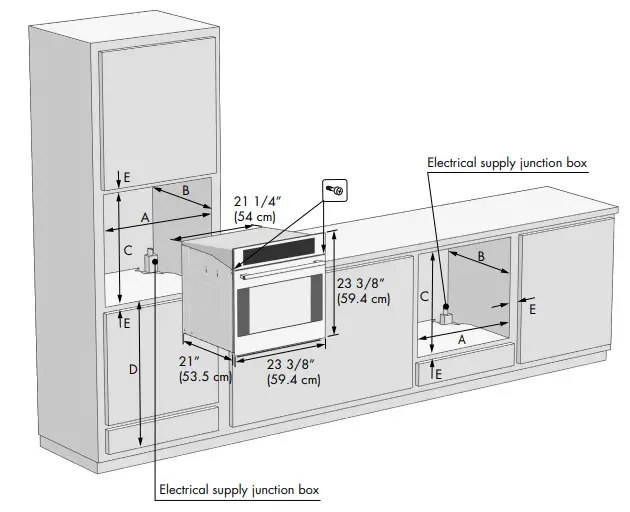
| Later. | DIMENSION | SINGLE | ||
| 24” | ||||
| F | Cutout Width | 23 | 5/8” | (60 cm) |
| G | Cutout Height | 24 | 1/64” | (61 cm) |
| H | Mounting Strip | 5/8” | ( 1.5 cm) | |
| I | Mounting Strip | 5/8” | ( 1.5 cm) | |
Electrical supply
Before installing the oven have a qualified electrician verify that your home is provided with adequate electrical service and that the addition of the oven will not overload the branch circuit on which it is to be installed. A separate three-wire or four-wire single phase, 120/240 Volt, 60 Hz, or a 120/208 Volt, 60Hz branch circuit is required.
NOTE: For use with 120/208 v, 60 Hz supply voltage, see connecting to a 208-volt circuit. For hook-up of the oven, you will need to have an approved junction box installed where it will be easily reached through the front of the cabinet where the oven will be located. The oven has 3 feet of conduit. Allow two to three feet of slack in the line so that the oven can be moved if servicing is ever necessary. DO NOT shorten the flexible conduit.
LOCATION OF RATING PLATE
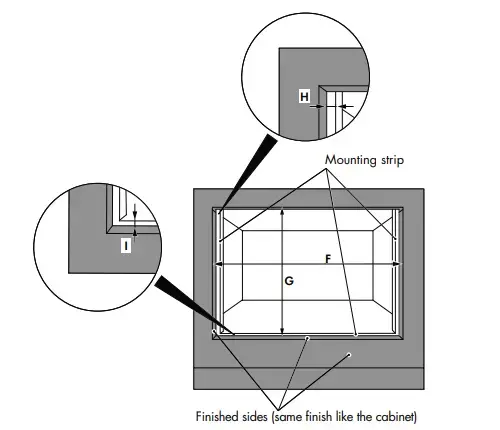
Wiring requirements
When making the wire connections, use the entire length of the conduit provided (3 feet). The conduit must not be cut. Before making connections make sure the power is off and read and observe the following:
- A separate three-wire or four-wire, single phase, 120V/240V, 60 Hz or 120V/208V, 60 Hz branch circuit is required for the oven.
- The oven must be connected with Copper or Aluminum wire.
In the United States
Wiring must conform to the National Electrical Code, ANSI/NFPA No. 70 latest edition. You can obtain a copy of the National Electrical Code by writing to: National, Fire Protection Association Batterymarch Park Quincy, MA 02269.
In Canada
Wiring must conform to Canadian Electrical Code C22.1- latest edition. You can obtain a copy of the Canadian Electrical Code by writing to: Canadian Standards Association 178 Rexdale Boulevard Rexdale (Toronto), Ontario, Canada M9W 1R3
- Wire size (Copper or Aluminum wire) and connections must] be suitable for the rating of the appliance as per the National Electrical Code requirements. The flexible armoured cable extending from the oven should be connected directly to the junction box.
- The junction box should be located so as to allow as much slack as possible between the junction box and the oven so it can be moved if servicing is ever required.
- A U.L. listed conduit connector must be provided at each end of the power supply cable.
WARNING: ELECTRICAL SHOCK HAZARD
- The electrical power to the oven branch circuit must be shut off while line connections are being made.
- Do not use an extension cord with this appliance.
- Electrical ground is required on this appliance. The free end of the green wire (the ground wire) must be connected to a suitable ground. This wire must remain grounded to the oven.
- If cold water pipe is interrupted by plastic, non metallic gaskets, union connections or other insulating materials,
- DO NOT use for grounding.
- DO NOT ground to a gas pipe.
- DO NOT have a fuse in the NEUTRAL or GROUNDING circuit. A fuse in the NEUTRAL or GROUNDING circuit could result in an electrical shock.
- Check with a qualified electrician if you are in doubt as to whether the appliance is properly grounded.
- Failure to follow these instructions could result in serious injury or death.
CAUTION: Do not repair or replace any part of the appliance unless specifically recommended in the manual. All other servicing should be done by a qualified technician. This may reduce the risk of personal injury and damage to the oven. Never modify or alter the construction of the appliance by removing panels, wire covers, screws, or any other part of the product.
Electrical connections
Be sure your appliance is properly installed and grounded by a qualified technician. Ask your dealer to recommend a qualified technician or an authorized repair service. This appliance is manufactured with a green GROUND wire connected to the oven chassis. After making sure that the power has been turned off, connect the flexible conduit from the oven to the junction box using a U.L. listed conduit connector. Figures A and B and the instructions provided below present the most common way of connecting the ovens. Your local codes and ordinances, of course, take precedence over these instructions. Complete electrical connections according to local codes and ordinances.
“WARNING” Risk of Electric Shock, frame grounded to neutral of the appliance through a link. Grounding through the neutral conductor is prohibited for new branch-circuit installations (1996 NEC); mobile homes; and recreational vehicles, or in an area where local codes prohibit grounding through the neutral conductor. For installations where grounding through the neutral conductor is prohibited:
- Disconnect the ground from the neutral at the free end of the conduit;
- Use grounding terminal or lead to the ground unit; and
- Connect neutral terminal or lead to branch circuit neutral in the usual manner.
3-Wire branch circuit (for US only)
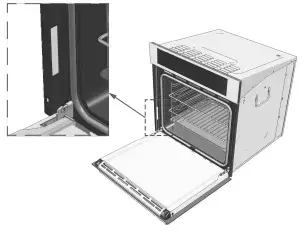
Refer to Figure A, where local codes allow the connection of GROUND wire from the oven to the branch circuit NEUTRAL wire (gray or white colored wire):
- If local codes permit, connect the green GROUND wirefrom the oven and the white wire from the oven to the branch circuit NEUTRAL wire (gray or white colored wire).
- Connect the red and black leads from the oven to the corresponding leads in the junction box.
4-Wire branch circuit (for the US and Canada)
Refer to Figure B: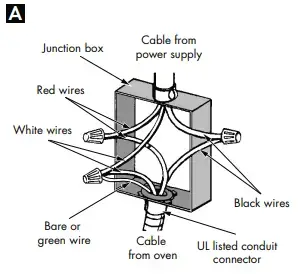
- Disconnect ground from neutral at a free end of the conduit.
- Connect the green GROUND wire from the oven to the GROUND wire in the junction box (bare or green colored wire).
- Connect the red and black leads from the oven to the corresponding leads in the junction box.
- Connect the white wire from the oven to the NEUTRAL (gray or white) wire in the junction box.
Final Checklist
To prevent improper connections leading to damage of electrical components and so voiding the warranty, the following steps must be performed:
- Check the electrical requirements and make sure you have the correct electrical supply and that the oven is properly grounded.
- Turn on the power supply to the oven.
- Check power at the junction box wires using a voltmeter having a range of 0-250 VAC.
- If you have installed the oven for use on 240 Volt supply, you should find that the voltage reading between the black and red wires (Line to Line) should be 220 to 240 Volts.
- If you have modified the oven(s) for use on 208 Volt, the voltage reading between the black and red wires should be 190 to 208 Volts.
- Test the oven mode. Select the BAKE mode. See the Use and Care Manual for detailed operating instructions.
- Verify that the oven light comes on and the oven begins to preheat.
- Test the door lock. Set the SELF-CLEAN mode. Confirm that the door locks when the lock icon appears in the display.
- If installing a double oven, test the second oven as well.
- To check the other oven functions refer to the “Using the Oven Controls” section of the USE AND CARE MANUAL.
- If the oven is working properly, turn off the power supply to the oven.
- Place the cover on the junction box and make sure the cover is securely fastened and turn on the power to the oven.
- Leave these INSTALLATION instructions as well as the USE AND CARE MANUAL with the owner.